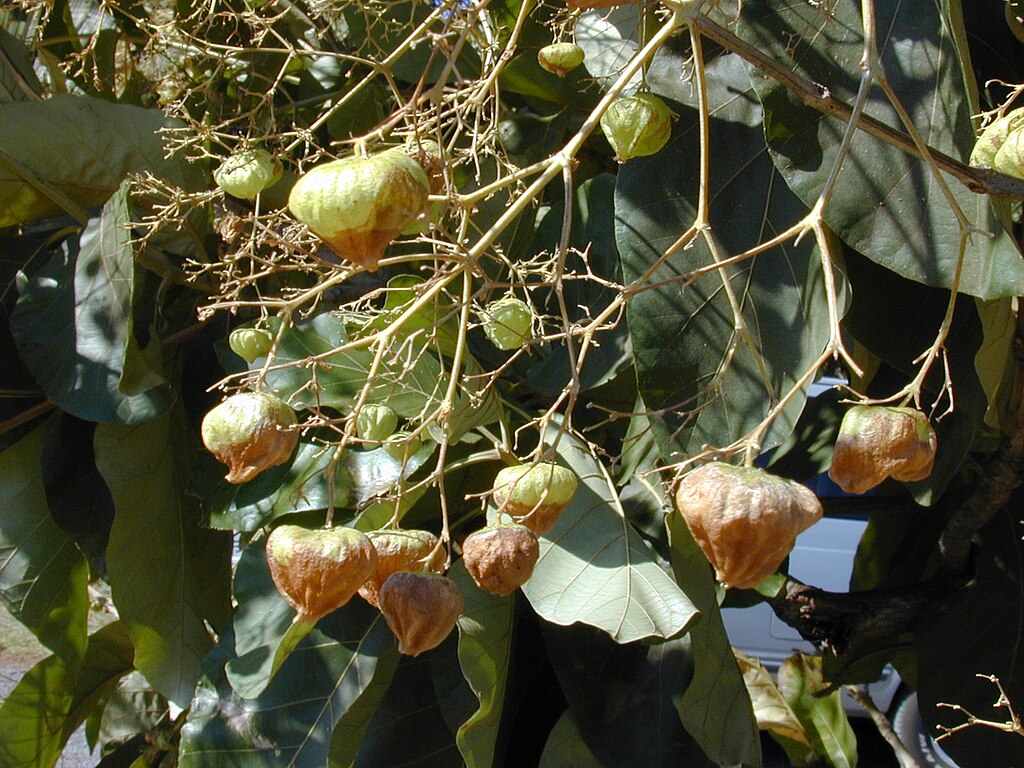Tectona grandis

|
|
Tectona grandis Common Names: Teak, teakwood, sagwan, jati Scientific
Classification Kingdom: Plantae Clade: Tracheophytes Clade: Angiosperms Clade: Eudicots Order: Lamiales Family: Lamiaceae Genus: Tectona Species: T. grandis Binomial Name: Tectona grandis L.f. Synonyms: Jatus grandis (L.f.) Kuntze, Tectona grandis f. abludens Koord. & Valeton, Theka grandis (L.f.) Lam. Morphological Description Tectona grandis, widely known as teak, is a large deciduous tree that typically
reaches heights of 20–40 meters, with exceptional specimens growing up to 50
meters in optimal conditions (Kew Science, 2024). The trunk is stout and often
fluted at the base, with a diameter of 1–2.5 meters, covered in grey to
greyish-brown bark that peels in thin strips with age (Singh et al., 2024).
Branches are quadrangular when young, transitioning to a rounded, dense crown.
Leaves are large, ovate to elliptic, 15–45 cm long and 8–23 cm wide, with a
rough upper surface and a pubescent underside, turning reddish in the dry
season (Tropical Plants Database, 2024). The tree produces small, fragrant
white flowers, 5–8 mm in diameter, arranged in large terminal panicles up to 40
cm long, blooming from June to August (Burkill, 2000). Fruits are small,
globose drupes, 1–2 cm in diameter, enclosed in a papery calyx, turning from
green to brown as they mature, containing 1–4 hard seeds. Distribution and Habitat Tectona grandis is native to South and Southeast Asia, with its natural
range extending across India, Myanmar, Laos, Thailand, and parts of Malaysia
and Indonesia (Kew Science, 2024). It thrives in mixed hardwood forests,
monsoon forests, and deciduous woodlands, often along riverbanks and hillsides
at elevations from sea level to 1,200 meters (CABI, 2024). The species prefers
well-drained, fertile soils—loamy, sandy, or lateritic—with a pH of 6.0–7.5 and
annual rainfall of 1,200–2,500 mm, though it tolerates dry seasons of 3–5
months (Tropical Plants Database, 2024). Due to its high-quality timber, teak
has been introduced and cultivated extensively in tropical regions of Africa
(e.g., Nigeria, Ghana), Central America (e.g., Costa Rica, Panama), the
Caribbean, and northern Australia, often in commercial plantations (Singh et
al., 2024). Ethnopharmacology Tectona grandis has a long history in traditional medicine across Asia and
Africa, attributed to its rich phytochemical profile, including flavonoids
(e.g., quercetin, apigenin), phenolic acids (e.g., gallic acid), tannins, and
terpenoids (e.g., lupeol) (Anand & Basavaraju, 2021). Below are key
ethnopharmacological uses supported by research: · Anti-inflammatory Effects: In India, leaf decoctions treat
inflammation and skin diseases; methanolic leaf extracts (200–400 mg/kg)
reduced carrageenan-induced paw edema in rats by 50–60%, linked to flavonoids
and phenolic compounds (Ramachandran et al., 2011). · Antimicrobial Properties: In Nigeria, bark infusions combat
infections; ethanolic extracts showed an MIC of 125 μg/mL against Staphylococcus aureus and Escherichia coli, attributed to tannins and terpenoids (Lanka
& Parimala, 2017). · Antioxidant Activity: In Thailand, leaf extracts are used as a
tonic; ethanolic extracts exhibited DPPH scavenging with an IC50 of 37.5 μg/mL
and FRAP values of 1.10 mmol Trolox/L, due to high phenolic content (Ghaisas et
al., 2008). · Antidiabetic Potential: In Myanmar, bark decoctions manage
diabetes. · Wound Healing: In Cameroon, leaf pastes promote wound healing; extracts accelerated
wound contraction by 70% in excision models in rats, linked to tannins and
antioxidant properties (Majumdar et al., 2007). ⚠ Toxicity Profile: Tectona grandis is generally safe for traditional
medicinal use, with no significant systemic toxicity reported at typical doses.
The wood contains silica (0.2–0.5%), which can cause respiratory irritation if
inhaled as dust during processing, and prolonged contact with sawdust may lead
to dermatitis in sensitive individuals due to quinones like tectoquinone
(Tropical Plants Database, 2024). Additional Uses · Timber Production: Teak’s durable, water-resistant wood, with
a density of 630–720 kg/m³, is prized for furniture, shipbuilding, and
construction, owing to natural oils like caoutchouc and tectoquinone that repel
termites (Singh et al., 2024). · Culinary and Fodder: Young leaves, rich in 3–5% protein, are
used as fodder for livestock in India, and occasionally cooked as a vegetable
in rural areas (Burkill, 2000). · Ecological Benefits: Teak plantations provide shade, stabilize
soil, and support biodiversity, though their monoculture can reduce native
species diversity (CABI, 2024). References
External Links More Pictures |
|
| Compounds of Tectona grandis |
|
| References |